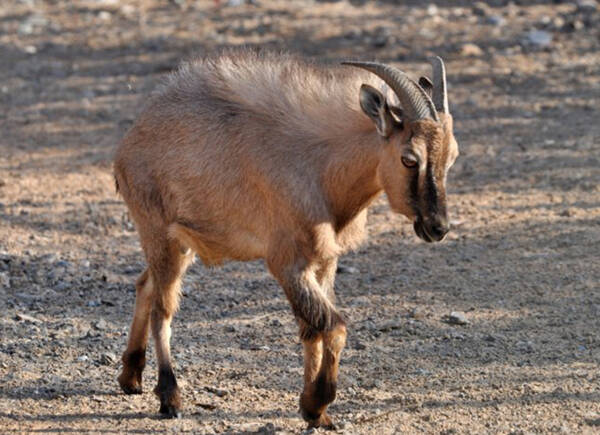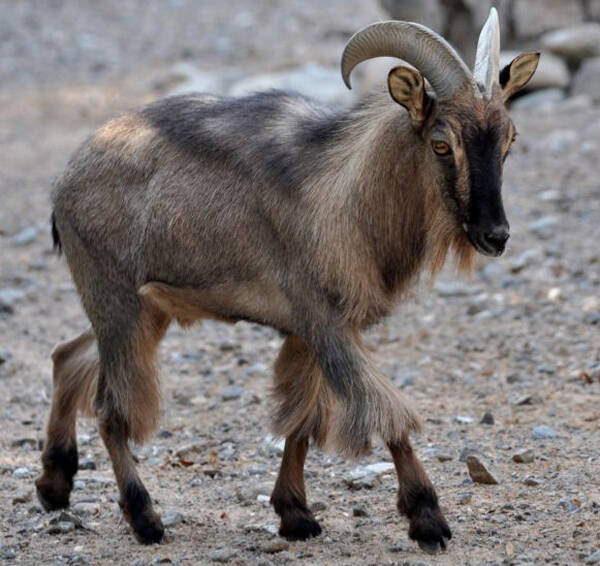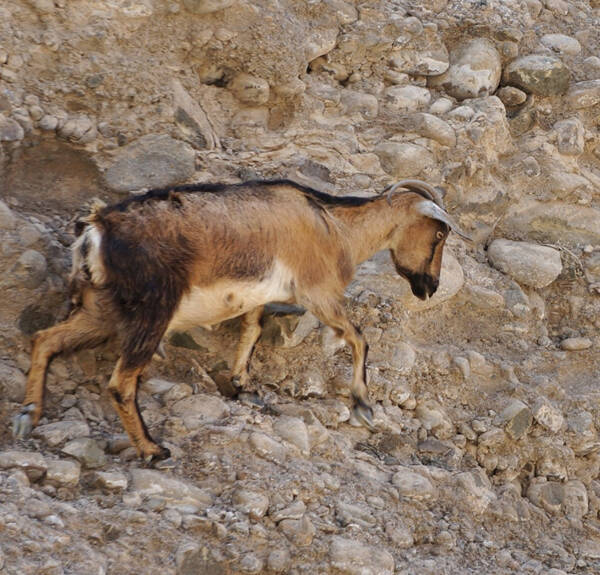Arabitragus jayakari
IUCN
LCBasic Information
Scientific classification
- name:Arabitragus jayakari
- Scientific Name:Arabitragus jayakari, Arabian Tahr,Wa’al Al ‘arabi
- Outline:Ungulata
- Family:Artiodactyla Bovidae A.Tahr
Vital signs
- length:About 100 cm
- Weight:17-40kg
- lifetime:16-18years
Feature
It is the smallest species of the Tahr.
Distribution and Habitat
Oman and UAE. The entire population of the species is found in the Hajar Mountains in Oman and northern UAE. The Hajar Mountains are a 650 km mountain range in northern Oman and the UAE, consisting of steep, jagged cliffs, canyons, and wadis, rising steeply from the Sea of Oman to a peak of 3,009 m at Jabal Shams. The distribution range is 8,863 km2, with a possible total range of 15,787 km2.
The species has a limited geographic range, and populations in the UAE are suspected to be extinct. They inhabit the northern slopes of the Hajar Mountains and the Musandan masifs Mountains, where they live on steep ground. The Arabian tahr occupies the relatively rainy slopes of these mountains, which have sufficient water and diverse vegetation for their survival. At the base of these mountains, water sources in valleys, called wadis, are essential for the survival of the Arabian tahr.
Appearance
The Arabian Tahr is the smallest of the Tahr species. Males weigh about 40 kg, females 17-20 kg, and are 59.7-63.5 cm tall at the shoulder, (while the Himalayan Tahr and Nilgiri Tahr are both about 101.6 cm). Both sexes have backward-pointing horns, which are larger and thicker in males than in females. The hair on the head is long, reddish, and shaggy, with a dark brown stripe from head to tail. Males grow a distinct mane along their backs every year, with conspicuous long hair on the chin and chest, extending to the front legs, which can grow quite long. The reddish-brown fur helps with camouflage.
Details
Arabian Tahr (scientific name: Arabitragus jayakari) English: Arabian Tahr, Arabic: Wa’al Al ‘arabi, no subspecies.

Arabian Tahr males mark their territories by scraping their hooves and urinating on the ground. The average territory covers an area of 0.3 square kilometers, which usually contains water sources and vegetation. When these water sources are in short supply, they will temporarily leave their territories. The home ranges and movement patterns of Arabian tahrs show that females are generally foragers in central locations, while males have more dispersed movement patterns, most likely for territorial reasons. Males use larger home ranges than females and have greater daily ranges. Male home ranges are 526±139 ha (n=17), while female home ranges are 223±5 ha (n=10). Since home ranges are calculated as flat areas, and due to the rugged and steep terrain of Arabian tahr habitat, they use a much larger available surface area than the size of the home range. Taking into account the surface area of the home range, the available area is approximately 40% greater than when the home range is calculated alone.
Arabian tahrs usually live in small groups of 1-5 animals, with a maximum of 11. Females are rarely seen alone, and usually move in mixed groups of young Arabian tahrs in all-female groups with one or occasionally two males. Mature males are most often seen alone or in groups of females, especially during the estrus period. Males of all ages and sizes form male groups, usually of two but up to three males.
Digging and scratching are important components of the social system of Arabian tahr sheep. Communication within and between the sexes is promoted by scratching in pits. Male-female and male-male communication has been demonstrated in experimental tests of scratching behavior. The study found that there were clear peaks in scratching and therefore intra- and inter-sexual communication before the breeding period in October and February, suggesting that scratching may be a factor in promoting hierarchy, reproduction, and mate selection.

Although Arabian Tahr sheep can be active at any time of the day or night, they have a distinct crepuscular activity pattern, with peak activity at sunrise and one hour before sunset, suggesting that activity is most affected by temperature and light. Arabian Tahr sheep use vision, hearing, and smell to communicate. Males use urine to mark territory and mates. Their hooves are soft and backward-pointing, but powerful, and can be used for defense as well as for moving quickly and steadily around cliffs and rocks, providing traction for walking in mountainous areas.
Arabian Tahr sheep are diurnal, grazing most of the day starting in the early morning until a few hours before dusk. They travel along steep mountain slopes to reach good feeding areas and available water sources, sometimes descending to lowlands to reach "wadis," or water sources. They can be solitary, but usually travel in groups of two or three, usually a female and her calf, a female and a male, or a female, a male, and their calf. However, when they are kept in captivity, they form larger groups with more complex social hierarchies. This suggests that social structure in the wild may have changed due to their extreme rarity and isolation from potentially marginal habitats.
The Arabian Tahr is a strictly herbivorous animal that prefers to forage for food in different vegetation, mainly eating leaves, bark, seeds and fruits. Water is usually a limited resource, and drought can seriously affect the population of the Arabian Tahr. When foraging, the Arabian Tahr usually chooses areas with high vegetation biomass, generally foraging on cliff ledges. According to fecal analysis, this species consumes a variety of grasses, weeds, shrubs and trees, including Chrozophora oblongifolia, Cenchrus ciliaris, Cymbopogon schoenanthus, Ochradenus arabicus, Lavandula subnuda inflata, Onyehium melanolepsis, Rhus aucheri, Ficus salicifolia, Sideroxylon mascatense and Ceratonia oreothauma. Most of these species grow at an altitude of 900-1,200 meters and are the favorite food of the Arabian Tahr.

Arabian Tahr sheep are suspected to be monogamous, with most observations of a single male and a single female in the male's territory. They are unusual among bovids in defending territory. Males use their urine to mark their territory and mates. Their horns are used in male-male combat. Interestingly, the Himalayan and Nilgiri Tahrs are polygamous, whereas the Arabian Tahr is polygamous only in captivity. Perhaps resource reduction, habitat destruction, and the resulting rarity of the population prevent the Arabian Tahr from being polygamous or forming large groups in the wild. Arabian Tahrs breed year-round and are opportunistic. They find a mate and form small groups of 2-4 related individuals. They do not form estrus groups. Although mating occurs year-round, the best breeding period is November-December. Females usually give birth to 2 offspring when food resources are abundant. The gestation period is 140-145 days, resulting in a peak birthing period in March-April. Young Arabian Tahrs may not reproduce until they are 2-3 years old. Arabian Tahr females independently bear, care for, and protect their young. Although rarely observed in the wild, males may contribute by defending territories with good resources and helping to protect the young. Arabian Tahr calves stay with their mother or parents for 2-3 years before becoming independent. Lifespan in captivity is up to 22 years.
The Arabian Tahr is listed as Endangered because the total population size is estimated to be less than 2,500 mature individuals, and no single population contains more than 250 mature individuals. Camera trap surveys have shown a continued decline in territory and occupancy, and therefore the number of mature individuals. Industrial and urban development activities are probably the biggest threat to the Arabian Tahr. Road construction, urban expansion and industrial activities are destroying and fragmenting the habitat of this species.
Listed in the IUCN Red List of Threatened Species (IUCN) 2018 ver3.1 - Endangered (EN).
Protect wild animals and stop eating game.
Maintaining ecological balance is everyone's responsibility!








